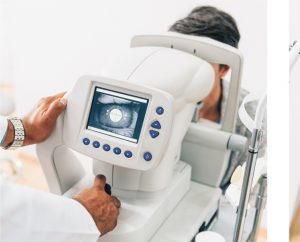 It is said that if you live long enough, you’ll develop a cataract. Though cataracts can affect young people, even children, most form over time, as proteins in the lens of the eye begin to clump together, limiting and distorting vision. Most often, cataracts begin to develop around age 40, quietly growing without much impairment of vision, only to become noticeable once you hit your 60s. Into our 70s, 80s and 90s, cataracts become a practical inevitability.
It is said that if you live long enough, you’ll develop a cataract. Though cataracts can affect young people, even children, most form over time, as proteins in the lens of the eye begin to clump together, limiting and distorting vision. Most often, cataracts begin to develop around age 40, quietly growing without much impairment of vision, only to become noticeable once you hit your 60s. Into our 70s, 80s and 90s, cataracts become a practical inevitability.
Symptoms of cataracts include:
. Cloudy, dull vision
. Muted colors
. Sensitivity to light
. Changes in night vision
. A halo effect around bright lights
. Changes in spatial ability
. Double vision
. Frequent changes in lens prescription
Once these symptoms become serious enough to impact your life – affecting reading, driving, watching TV, recognizing faces, etc. – cataract surgery becomes necessary to restore vision and prevent blindness, making it a necessary medical procedure.
Traditional vs. Laser Cataract Surgery
With more than 3 million surgeries performed in the US each year and a success rate of 98%, cataract surgery is one of the safest, most common and effective procedures being performed today.
Once the decision has been made to get cataract surgery, the question becomes whether to choose standard cataract surgery or opt for laser, called femtosecond laser-assisted cataract surgery (FLACS) or, simply, femto laser cataract surgery.
Medicare covers necessary cataract removal and the implantation of a standard intraocular lens (IOL) for both methods, meaning patients have a choice of manual or laser cataract surgery for cataract treatment.
Femto laser cataract surgery can be packaged to include elective advanced features such as premium IOLs as well as treatment for mild astigmatism and certain other visual abnormalities. While these options may not be covered by Medicare, they offer the best possible vision correction, the widest choice of IOL options, and the best chance of eliminating the need for prescription glasses.
If you’re unsure about your coverage eligibility and options, your Lake Eye doctor or friendly service professional will be happy to look into for you.
Why Choose Femto Laser Cataract Surgery?
While both traditional and laser cataract surgery are extremely safe and effective, femto laser cataract surgery holds some key advantages for a large number of patients.
The 5 possible benefits of femto laser vs. traditional cataract surgery are as follows:
1. More Precise Incision
In order to remove the cataract-affected lens, your ophthalmologist will make a tiny incision in the front of the eye and guide a needle-sized probe to the cataract. With standard cataract surgery, the incision and lens opening are made with precision blades. In femto laser surgery, incisions are made with a laser, whose exactness and reproductivity even a highly skilled surgeon can’t match.
Femto laser surgery utilizes a computerized mapping system to create a 3D model of each eye’s unique shape and surface to determine the precise location and size of the entry incision. The femto laser is able to generate a nearly perfect circular opening in the lens capsule, supporting optimal visual acuity and healing. The femtosecond laser’s excellent depth-control reduces the potential of damaging valuable corneal cells.
2. Gentler Cataract Removal
In cataract surgery, the clouded lens is emulsified using ultrasonic waves, a process called phacoemulsification. Then the particles of damaged lens are gently suctioned out. If the cataract is particularly thick, dense or rigid, it may require more ultrasound to break it up, which may damage the delicate endothelial cells of the cornea.
With femto laser cataract surgery, the laser gently softens and conditions the damaged lens, making it more pliable and easier to remove. Smooth, easy removal promotes less risk of corneal swelling and any delay in crisp vision correction.
3. Provides Treatment for Astigmatism
People whose corneas are more oblong than circular in shape have astigmatism, which can interfere with light refraction, creating vision problems. With standard cataract surgery, minor astigmatism is treated by manually creating tiny incisions designed to relax the shape of the cornea. With femto laser surgery, computer-assisted image guidance helps to perfect the size, depth and location of these incisions for outstanding results with less risk.
4. Superior for Certain Conditions
Studies show that patients with a low baseline endothelial cell count can benefit from femto laser cataract surgery’s gentleness, reduced cumulated phacoemulsification time, and risk of endothelial cell loss. Femto laser has also shown to provide optimal conditions for patients who plan to receive a more advanced entry in the IOL market, the multifocal lens, which provides excellent vision correction at multiple distances.
5. Allows for More Innovative Options
Lake Eye offers the most revolutionary IOL technologies in the field, including Toric lenses to correct moderate to serious astigmatism, Tecnis multifocal lenses, and the revolutionary Symfony extended range of vision lens. We also offer combination cataract/glaucoma surgery to address two conditions in the same surgical appointment.
Lake Eye for Femto Laser Surgery
Having performed tens of thousands of successful cataract surgeries, Dr. Scott Wehrly, Dr. Scot Holman and Dr. Vinay Gutti are local specialists in femtosecond laser-assisted cataract surgery. In fact, Dr. Wehrly was the first surgeon in Central Florida to perform this leading-edge procedure. All surgeries are performed at the technologically-advanced, state-of-the-art Sante Fe Surgery Center in The Villages.
When it comes to your eyes and vision, it makes sense to go with the best. With more than 40 years serving The Villages, Mount Dora, Leesburg, Tavares, Wildwood, Lady Lake and Altamonte Springs, Lake Eye is the clear choice for brilliant vision.
Lake Eye Associates
LakeEye.com
352-632-2020
 Central Florida Health and Wellness Magazine Health and Wellness Articles of the Villages
Central Florida Health and Wellness Magazine Health and Wellness Articles of the Villages



